
- •Introduction
- •Who This Book Is For
- •What This Book Covers
- •How This Book Is Structured
- •What You Need to Use This Book
- •Conventions
- •Source Code
- •Errata
- •p2p.wrox.com
- •What Are Regular Expressions?
- •What Can Regular Expressions Be Used For?
- •Finding Doubled Words
- •Checking Input from Web Forms
- •Changing Date Formats
- •Finding Incorrect Case
- •Adding Links to URLs
- •Regular Expressions You Already Use
- •Search and Replace in Word Processors
- •Directory Listings
- •Online Searching
- •Why Regular Expressions Seem Intimidating
- •Compact, Cryptic Syntax
- •Whitespace Can Significantly Alter the Meaning
- •No Standards Body
- •Differences between Implementations
- •Characters Change Meaning in Different Contexts
- •Regular Expressions Can Be Case Sensitive
- •Case-Sensitive and Case-Insensitive Matching
- •Case and Metacharacters
- •Continual Evolution in Techniques Supported
- •Multiple Solutions for a Single Problem
- •What You Want to Do with a Regular Expression
- •Replacing Text in Quantity
- •Regular Expression Tools
- •findstr
- •Microsoft Word
- •StarOffice Writer/OpenOffice.org Writer
- •Komodo Rx Package
- •PowerGrep
- •Microsoft Excel
- •JavaScript and JScript
- •VBScript
- •Visual Basic.NET
- •Java
- •Perl
- •MySQL
- •SQL Server 2000
- •W3C XML Schema
- •An Analytical Approach to Using Regular Expressions
- •Express and Document What You Want to Do in English
- •Consider the Regular Expression Options Available
- •Consider Sensitivity and Specificity
- •Create Appropriate Regular Expressions
- •Document All but Simple Regular Expressions
- •Document What You Expect the Regular Expression to Do
- •Document What You Want to Match
- •Test the Results of a Regular Expression
- •Matching Single Characters
- •Matching Sequences of Characters That Each Occur Once
- •Introducing Metacharacters
- •Matching Sequences of Different Characters
- •Matching Optional Characters
- •Matching Multiple Optional Characters
- •Other Cardinality Operators
- •The * Quantifier
- •The + Quantifier
- •The Curly-Brace Syntax
- •The {n} Syntax
- •The {n,m} Syntax
- •Exercises
- •Regular Expression Metacharacters
- •Thinking about Characters and Positions
- •The Period (.) Metacharacter
- •Matching Variably Structured Part Numbers
- •Matching a Literal Period
- •The \w Metacharacter
- •The \W Metacharacter
- •Digits and Nondigits
- •The \d Metacharacter
- •Canadian Postal Code Example
- •The \D Metacharacter
- •Alternatives to \d and \D
- •The \s Metacharacter
- •Handling Optional Whitespace
- •The \S Metacharacter
- •The \t Metacharacter
- •The \n Metacharacter
- •Escaped Characters
- •Finding the Backslash
- •Modifiers
- •Global Search
- •Case-Insensitive Search
- •Exercises
- •Introduction to Character Classes
- •Choice between Two Characters
- •Using Quantifiers with Character Classes
- •Using the \b Metacharacter in Character Classes
- •Selecting Literal Square Brackets
- •Using Ranges in Character Classes
- •Alphabetic Ranges
- •Use [A-z] With Care
- •Digit Ranges in Character Classes
- •Hexadecimal Numbers
- •IP Addresses
- •Reverse Ranges in Character Classes
- •A Potential Range Trap
- •Finding HTML Heading Elements
- •Metacharacter Meaning within Character Classes
- •The ^ metacharacter
- •How to Use the - Metacharacter
- •Negated Character Classes
- •Combining Positive and Negative Character Classes
- •POSIX Character Classes
- •The [:alnum:] Character Class
- •Exercises
- •String, Line, and Word Boundaries
- •The ^ Metacharacter
- •The ^ Metacharacter and Multiline Mode
- •The $ Metacharacter
- •The $ Metacharacter in Multiline Mode
- •Using the ^ and $ Metacharacters Together
- •Matching Blank Lines
- •Working with Dollar Amounts
- •Revisiting the IP Address Example
- •What Is a Word?
- •Identifying Word Boundaries
- •The \< Syntax
- •The \>Syntax
- •The \b Syntax
- •The \B Metacharacter
- •Less-Common Word-Boundary Metacharacters
- •Exercises
- •Grouping Using Parentheses
- •Parentheses and Quantifiers
- •Matching Literal Parentheses
- •U.S. Telephone Number Example
- •Alternation
- •Choosing among Multiple Options
- •Unexpected Alternation Behavior
- •Capturing Parentheses
- •Numbering of Captured Groups
- •Numbering When Using Nested Parentheses
- •Named Groups
- •Non-Capturing Parentheses
- •Back References
- •Exercises
- •Why You Need Lookahead and Lookbehind
- •The (? metacharacters
- •Lookahead
- •Positive Lookahead
- •Negative Lookahead
- •Positive Lookahead Examples
- •Positive Lookahead in the Same Document
- •Inserting an Apostrophe
- •Lookbehind
- •Positive Lookbehind
- •Negative Lookbehind
- •How to Match Positions
- •Adding Commas to Large Numbers
- •Exercises
- •What Are Sensitivity and Specificity?
- •Extreme Sensitivity, Awful Specificity
- •Email Addresses Example
- •Replacing Hyphens Example
- •The Sensitivity/Specificity Trade-Off
- •Sensitivity, Specificity, and Positional Characters
- •Sensitivity, Specificity, and Modes
- •Sensitivity, Specificity, and Lookahead and Lookbehind
- •How Much Should the Regular Expressions Do?
- •Abbreviations
- •Characters from Other Languages
- •Names
- •Sensitivity and How to Achieve It
- •Specificity and How to Maximize It
- •Exercises
- •Documenting Regular Expressions
- •Document the Problem Definition
- •Add Comments to Your Code
- •Making Use of Extended Mode
- •Know Your Data
- •Abbreviations
- •Proper Names
- •Incorrect Spelling
- •Creating Test Cases
- •Debugging Regular Expressions
- •Treacherous Whitespace
- •Backslashes Causing Problems
- •Considering Other Causes
- •The User Interface
- •Metacharacters Available
- •Quantifiers
- •The @ Quantifier
- •The {n,m} Syntax
- •Modes
- •Character Classes
- •Back References
- •Lookahead and Lookbehind
- •Lazy Matching versus Greedy Matching
- •Examples
- •Character Class Examples, Including Ranges
- •Whole Word Searches
- •Search-and-Replace Examples
- •Changing Name Structure Using Back References
- •Manipulating Dates
- •The Star Training Company Example
- •Regular Expressions in Visual Basic for Applications
- •Exercises
- •The User Interface
- •Metacharacters Available
- •Quantifiers
- •Modes
- •Character Classes
- •Alternation
- •Back References
- •Lookahead and Lookbehind
- •Search Example
- •Search-and-Replace Example
- •Online Chats
- •POSIX Character Classes
- •Matching Numeric Digits
- •Exercises
- •Introducing findstr
- •Finding Literal Text
- •Quantifiers
- •Character Classes
- •Command-Line Switch Examples
- •The /v Switch
- •The /a Switch
- •Single File Examples
- •Simple Character Class Example
- •Find Protocols Example
- •Multiple File Example
- •A Filelist Example
- •Exercises
- •The PowerGREP Interface
- •A Simple Find Example
- •The Replace Tab
- •The File Finder Tab
- •Syntax Coloring
- •Other Tabs
- •Numeric Digits and Alphabetic Characters
- •Quantifiers
- •Back References
- •Alternation
- •Line Position Metacharacters
- •Word-Boundary Metacharacters
- •Lookahead and Lookbehind
- •Longer Examples
- •Finding HTML Horizontal Rule Elements
- •Matching Time Example
- •Exercises
- •The Excel Find Interface
- •Escaping Wildcard Characters
- •Using Wildcards in Data Forms
- •Using Wildcards in Filters
- •Exercises
- •Using LIKE with Regular Expressions
- •The % Metacharacter
- •The _ Metacharacter
- •Character Classes
- •Negated Character Classes
- •Using Full-Text Search
- •Using The CONTAINS Predicate
- •Document Filters on Image Columns
- •Exercises
- •Using the _ and % Metacharacters
- •Testing Matching of Literals: _ and % Metacharacters
- •Using Positional Metacharacters
- •Using Character Classes
- •Quantifiers
- •Social Security Number Example
- •Exercises
- •The Interface to Metacharacters in Microsoft Access
- •Creating a Hard-Wired Query
- •Creating a Parameter Query
- •Using the ? Metacharacter
- •Using the * Metacharacter
- •Using the # Metacharacter
- •Using the # Character with Date/Time Data
- •Using Character Classes in Access
- •Exercises
- •The RegExp Object
- •Attributes of the RegExp Object
- •The Other Properties of the RegExp Object
- •The test() Method of the RegExp Object
- •The exec() Method of the RegExp Object
- •The String Object
- •Metacharacters in JavaScript and JScript
- •SSN Validation Example
- •Exercises
- •The RegExp Object and How to Use It
- •Quantifiers
- •Positional Metacharacters
- •Character Classes
- •Word Boundaries
- •Lookahead
- •Grouping and Nongrouping Parentheses
- •Exercises
- •The System.Text.RegularExpressions namespace
- •A Simple Visual Basic .NET Example
- •The Classes of System.Text.RegularExpressions
- •The Regex Object
- •Using the Match Object and Matches Collection
- •Using the Match.Success Property and Match.NextMatch Method
- •The GroupCollection and Group Classes
- •The CaptureCollection and Capture Class
- •The RegexOptions Enumeration
- •Case-Insensitive Matching: The IgnoreCase Option
- •Multiline Matching: The Effect on the ^ and $ Metacharacters
- •Right to Left Matching: The RightToLeft Option
- •Lookahead and Lookbehind
- •Exercises
- •An Introductory Example
- •The Classes of System.Text.RegularExpressions
- •The Regex Class
- •The Options Property of the Regex Class
- •Regex Class Methods
- •The CompileToAssembly() Method
- •The GetGroupNames() Method
- •The GetGroupNumbers() Method
- •GroupNumberFromName() and GroupNameFromNumber() Methods
- •The IsMatch() Method
- •The Match() Method
- •The Matches() Method
- •The Replace() Method
- •The Split() Method
- •Using the Static Methods of the Regex Class
- •The IsMatch() Method as a Static
- •The Match() Method as a Static
- •The Matches() Method as a Static
- •The Replace() Method as a Static
- •The Split() Method as a Static
- •The Match and Matches Classes
- •The Match Class
- •The GroupCollection and Group Classes
- •The RegexOptions Class
- •The IgnorePatternWhitespace Option
- •Metacharacters Supported in Visual C# .NET
- •Using Named Groups
- •Using Back References
- •Exercise
- •The ereg() Set of Functions
- •The ereg() Function
- •The ereg() Function with Three Arguments
- •The eregi() Function
- •The ereg_replace() Function
- •The eregi_replace() Function
- •The split() Function
- •The spliti() Function
- •The sql_regcase() Function
- •Perl Compatible Regular Expressions
- •Pattern Delimiters in PCRE
- •Escaping Pattern Delimiters
- •Matching Modifiers in PCRE
- •Using the preg_match() Function
- •Using the preg_match_all() Function
- •Using the preg_grep() Function
- •Using the preg_quote() Function
- •Using the preg_replace() Function
- •Using the preg_replace_callback() Function
- •Using the preg_split() Function
- •Supported Metacharacters with ereg()
- •Using POSIX Character Classes with PHP
- •Supported Metacharacters with PCRE
- •Positional Metacharacters
- •Character Classes in PHP
- •Documenting PHP Regular Expressions
- •Exercises
- •W3C XML Schema Basics
- •Tools for Using W3C XML Schema
- •Comparing XML Schema and DTDs
- •How Constraints Are Expressed in W3C XML Schema
- •W3C XML Schema Datatypes
- •Derivation by Restriction
- •Unicode and W3C XML Schema
- •Unicode Overview
- •Using Unicode Character Classes
- •Matching Decimal Numbers
- •Mixing Unicode Character Classes with Other Metacharacters
- •Unicode Character Blocks
- •Using Unicode Character Blocks
- •Metacharacters Supported in W3C XML Schema
- •Positional Metacharacters
- •Matching Numeric Digits
- •Alternation
- •Using the \w and \s Metacharacters
- •Escaping Metacharacters
- •Exercises
- •Introduction to the java.util.regex Package
- •Obtaining and Installing Java
- •The Pattern Class
- •Using the matches() Method Statically
- •Two Simple Java Examples
- •The Properties (Fields) of the Pattern Class
- •The CASE_INSENSITIVE Flag
- •Using the COMMENTS Flag
- •The DOTALL Flag
- •The MULTILINE Flag
- •The UNICODE_CASE Flag
- •The UNIX_LINES Flag
- •The Methods of the Pattern Class
- •The compile() Method
- •The flags() Method
- •The matcher() Method
- •The matches() Method
- •The pattern() Method
- •The split() Method
- •The Matcher Class
- •The appendReplacement() Method
- •The appendTail() Method
- •The end() Method
- •The find() Method
- •The group() Method
- •The groupCount() Method
- •The lookingAt() Method
- •The matches() Method
- •The pattern() Method
- •The replaceAll() Method
- •The replaceFirst() Method
- •The reset() Method
- •The start() Method
- •The PatternSyntaxException Class
- •Using the \d Metacharacter
- •Character Classes
- •The POSIX Character Classes in the java.util.regex Package
- •Unicode Character Classes and Character Blocks
- •Using Escaped Characters
- •Using Methods of the String Class
- •Using the matches() Method
- •Using the replaceFirst() Method
- •Using the replaceAll() Method
- •Using the split() Method
- •Exercises
- •Obtaining and Installing Perl
- •Creating a Simple Perl Program
- •Basics of Perl Regular Expression Usage
- •Using the m// Operator
- •Using Other Regular Expression Delimiters
- •Matching Using Variable Substitution
- •Using the s/// Operator
- •Using s/// with the Global Modifier
- •Using s/// with the Default Variable
- •Using the split Operator
- •Using Quantifiers in Perl
- •Using Positional Metacharacters
- •Captured Groups in Perl
- •Using Back References in Perl
- •Using Alternation
- •Using Character Classes in Perl
- •Using Lookahead
- •Using Lookbehind
- •Escaping Metacharacters
- •A Simple Perl Regex Tester
- •Exercises
- •Index
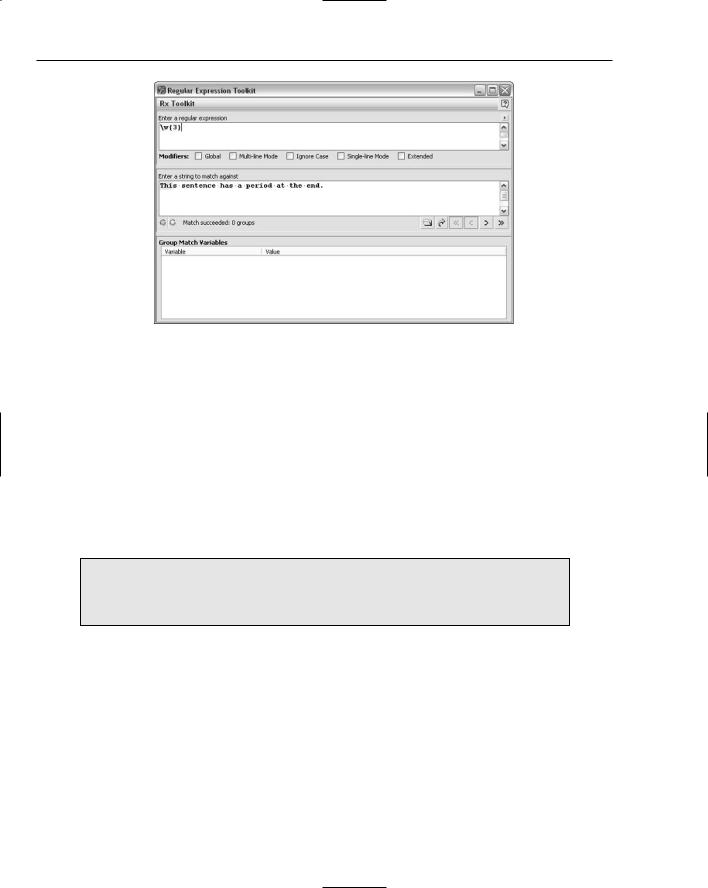
Chapter 4
Figure 4-5
How It Works
The pattern \w indicates that an ASCII alphabetic character (upperor lowercase A through Z or a through z), a numeric digit, or an underscore is to be matched. The quantifier {3} indicates that three successive “word” characters are to be matched.
The regular expression engine starts its attempts at matching at the position before the T of This. It first attempts to match a word character. Because the uppercase T is an alphabetic character, there is a match. It next attempts to find another word character. Because the h of This is an alphabetic character that too matches. Finally, it attempts to match a third word character. Because the i of This is also an alphabetic character, there is a third match. Because all components of the pattern match, the whole pattern matches. The sequence of three word characters Thi is therefore highlighted in pale green.
The term word character used to refer to the characters matched by the \w metacharacter is potentially misleading, because for many people, numeric digits and the underscore character won’t be thought of as word characters.
The \W Metacharacter
The \W metacharacter matches characters that are not matched by the \w metacharacter. In other words, the \W metacharacter matches any character other than ASCII alphabetic characters, numeric digits, or the underscore character.
82
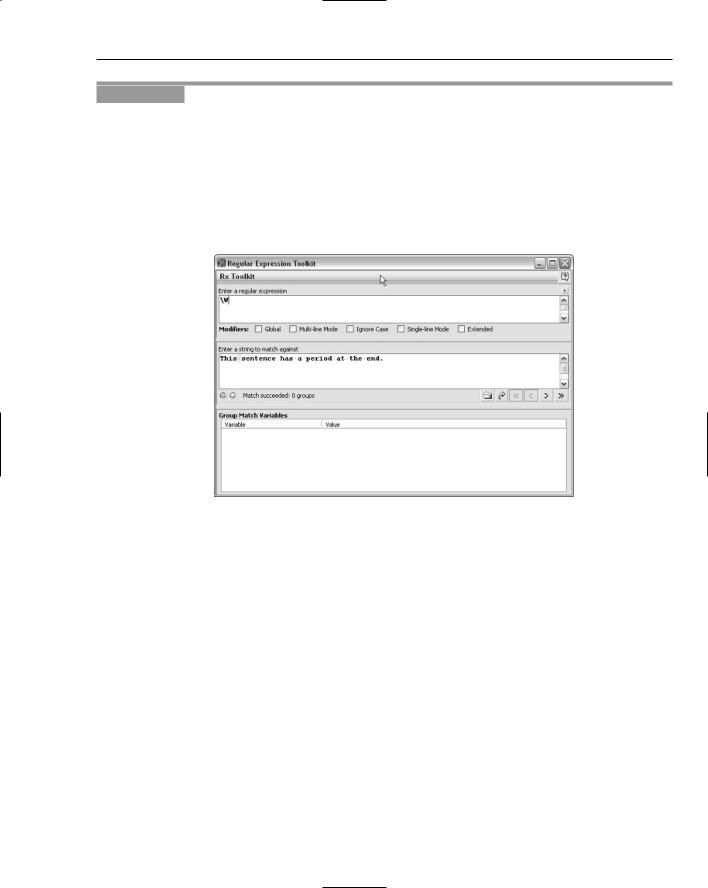
Metacharacters and Modifiers
Try It Out |
Matching Using the \W Metacharacter |
1.Open the Komodo Regular Expression Toolkit, and delete any residual regular expression pattern and test text.
2.In the Enter a String to Match Against area, enter the text This sentence has a period at the end.
3.In the Enter a Regular Expression area, enter the pattern \W.
4.Inspect the results in the Enter a String to Match Against area and in the gray area below it. The expected result is that the space character after This and before sentence should be highlighted in pale green when viewed on-screen (see Figure 4-6).
Figure 4-6
How It Works
The regular expression engine starts at the position before the uppercase T of This. It first attempts to match the uppercase T of This against the pattern \W. There is no match. It attempts to match each of the remaining characters of This in turn, but none of them matches the \W pattern, because each of those characters are “word characters.” When the regular expression engine reaches the position after the final s of This, the match succeeds because the space character that follows is not a word character and therefore matches the \W metasequence. Therefore, the matching character (the space character that follows This and precedes sentence) is highlighted.
Digits and Nondigits
Many regular expression implementations have characters that signify numeric digits or characters other than numeric digits.
The metacharacter \d is widely used to signify numeric digits. The metacharacter \D is used to signify nondigits in implementations that support the \d metacharacter.
83
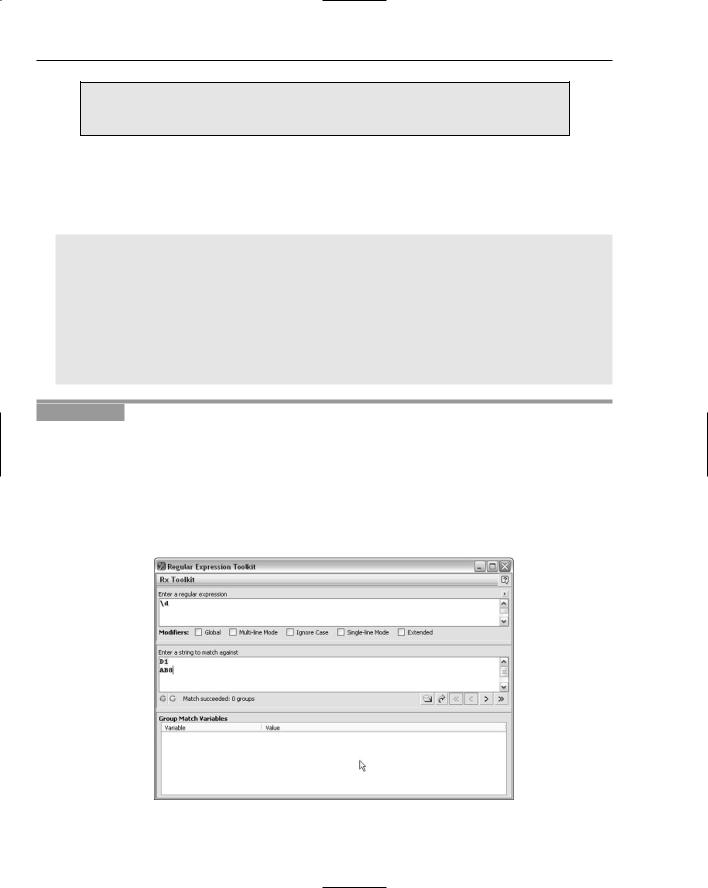
Chapter 4
OpenOffice.org Writer does not support the \d and \D metacharacters and so can’t be used to demonstrate these features.
The \d Metacharacter
The \d metacharacter matches one numeric digit 0 through 9.
A sample file, Digits.txt, is shown here:
D1
AB8
DE9
7ED
6py
0EC
E3
D2
F4
GHI5
ABC89
Try It Out Matching against the \d Metacharacter
1.Open the Komodo Regular Expressions Toolkit, and clear any residual regular expression and test text.
2.In the Enter a String to Match Against area, enter the first two lines from Digits.txt.
3.In the Enter a Regular Expression area, type the pattern \d.
4.Inspect the results in the Enter a String to Match Against area and in the gray area below it. Figure 4-7 shows the appearance expected after this step.
Figure 4-7
84

Metacharacters and Modifiers
How It Works
The \d metacharacter matches a numeric digit. The regular expression engine starts matching at the position before the D of D1. The first character, D, is not a numeric digit, and therefore, there is no match. The regular expression engine moves on to the position after the D and attempts to match the character that follows that position. Because the next character is the numeric digit 1, there is a match.
Canadian Postal Code Example
Canadian postcodes take the form A1A 1A1, with an alphabetic character preceding a numeric digit, which in turn is followed by an alphabetic character. That in turn is followed by a space character (usually one), which is followed by one numeric digit, followed by one alphabetic character, followed by a numeric digit.
To match a Canadian postal code, you can use the following problem definition:
Match an ASCII alphabetic character, followed by a numeric digit, followed by an ASCII alphabetic character, followed by an optional space character, followed by a numeric digit, followed by an ASCII alphabetic character, followed by a numeric digit.
The sample file CanPostcodes.txt has sample sequences of characters, some of which take the format just described, which are consistent with the structure of Canadian postal codes (although the examples in the file are simply character sequences). Not all alphabetic characters are currently used in the first position in a Canadian postal code. Further information is available at www.canadapost.com.
T3Z 3N7
D8R 8C4
RR4 88D
P9C 3Q4
V2X 3RU
V5R8S4
M8N 7LK J1M6U4 S1B 2R9 88B U2L D7R 7L2 F9Z6G4
A careful look at the sample data indicates that some lines have sequences of three alphanumeric characters, followed by a space character, followed by three more alphanumeric characters. Other lines have no space character. So if you are to detect all valid character sequences, you must allow for the optional nature of the space character.
First, let’s design a pattern that will match the sequences of characters that omit the space character. You want to match an alphabetic character first, which you can express using the metacharacter \w, followed by a numeric digit, which is matched by the metacharacter \d. If you don’t make allowance for the optional existence of a space character, you could use the following pattern:
\w\d\w\d\w\d
It matches the character, digit, character, digit, character, digit sequence that forms a Canadian postal code.
85
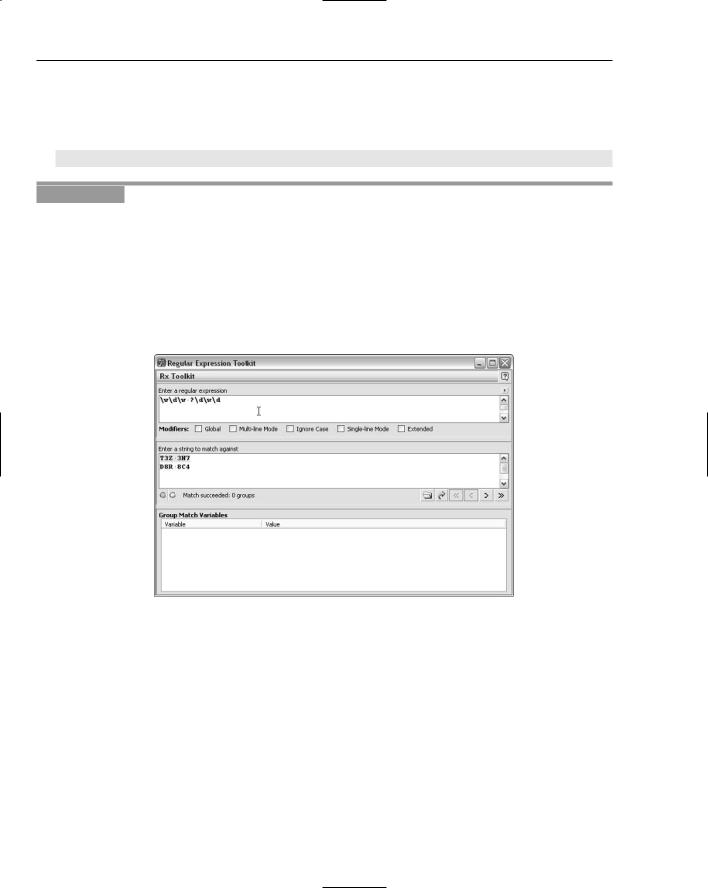
Chapter 4
To allow for an optional space character, you can simply add a space character to the pattern with a ? quantifier, if you assume that only a single space character is possible, or a * quantifier if you assume that optionally, there may be multiple space characters. Assuming that there is no space character or a single space character, you would have the following pattern:
\w\d\w ?\d\w\d
Try It Out |
Matching Canadian Postcode 1 |
1.Open the Komodo Regular Expression Toolkit, and clear any residual regular expression and test text.
2.In the Enter a String to Match Against area, enter the first two lines of CanPostcodes.txt as the test string.
3.In the Enter a Regular Expression area, enter the pattern \w\d\w ?\d\w\d.
4.Inspect the results in the Enter a String to Match Against area and in the gray area below it, as shown in Figure 4-8.
Figure 4-8
How It Works
The text T3Z 3N7 matches. The regular expression engine starts at the position before the uppercase T and attempts to match the character following that position against the first metacharacter, \w. That matches because T is an ASCII alphabetic character. It next attempts to match the \d metacharacter against the numeric digit 3. That too matches. The next attempt is to match the pattern \w against the
86

Metacharacters and Modifiers
uppercase character Z. That too matches. Next, an attempt is made to match the pattern ? (a space character followed by the ? quantifier) against a single space character (displayed as a mid dot in the Komodo Regular Expression Toolkit). That matches. Next, it attempts to match the pattern \d against the second numeric digit 3. That too matches. Next, it attempts to match the pattern \w against the uppercase N. Because that is an alphabetic character, there is a match. Finally, it attempts to match the metacharacter \d against the numeric digit 7. Because all components of the regular expression pattern match, the whole pattern matches. The matching text is highlighted in pale green in the Komodo Regular Expression Toolkit.
If you wish to match characters sequences that require at least one space character, you can use the + quantifier, which matches one or more occurrences of the preceding character or group.
Some regular expression implementations (for example, OpenOffice.org Writer) don’t support the \w and \d metacharacters and require the use of character classes, which are described in more detail in Chapter 5.
The following character class corresponds to the metacharacter \w:
[A-Za-z0-9_]
And the following character class corresponds to the metacharacter \d:
[0-9]
Assume that Canadian postal codes use only uppercase alphabetic characters. Using character classes, the following pattern would give the same results as the previous pattern, except that only uppercase alphabetic characters are matched:
[A-Z][0-9][A-Z] ?[0-9][A-Z][0-9]
Try It Out |
Alternative Approach to Canadian Postcodes |
1.Open OpenOffice.org Writer, and open the test file CanPostcodes.txt.
2.Use the Ctrl+F keyboard shortcut to open the Find and Replace dialog box.
3.Check the Regular Expressions and Match Case check boxes.
4.Enter the pattern [A-Z][0-9][A-Z] ?[0-9][A-Z][0-9] in the Search For text box.
5.Inspect the highlighted text, which indicates matches for the regular expression pattern. Figure 4-9 shows this pattern used in OpenOffice.org Writer on CanPostcodes.txt.
87
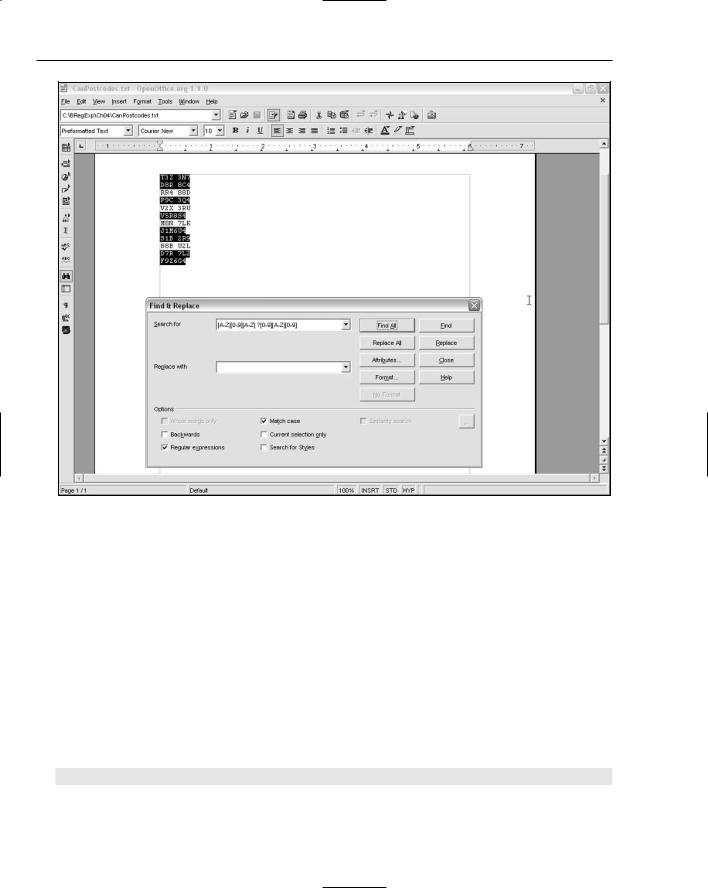
Chapter 4
Figure 4-9
How It Works
The text T3Z 3N7 matches. The regular expression engine starts at the position before the uppercase T and attempts to match the character following that position against the first metacharacter, [A-Z]. That matches. It next attempts to match the [0-9] character class metacharacter against the numeric digit 3. That too matches. The next attempt is to match the pattern [A-Z] against the character Z. That too matches. Next, an attempt is made to match the pattern ? (a space character followed by the ? quantifier) against a single space character. That matches. Next, it attempts to match the pattern [0-9] against the second numeric digit 3. That too matches. Next, it attempts to match the pattern [A-Z] against the uppercase N. Because that is an alphabetic character, there is a match. Finally, it attempts to match the metacharacter [0-9] against the numeric digit 7. Because all components of the regular expression pattern match, the whole pattern matches. The matching text is highlighted in OpenOffice.org Writer.
If you assumed that lowercase alphabetic characters were also allowed, a pattern like this would be required to allow for the possible existence of upperand lowercase characters:
[A-Za-z][0-9][A-Za-z] ?[0-9][A-Za-z][0-9]
88
